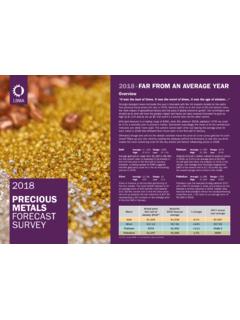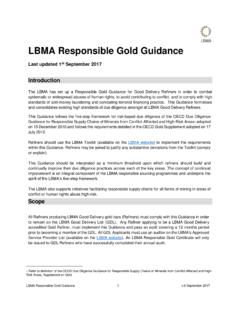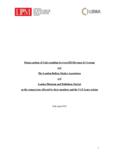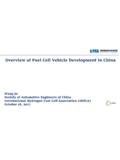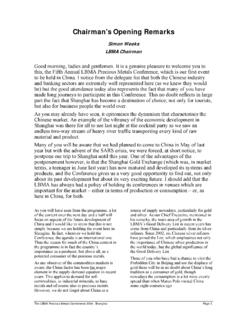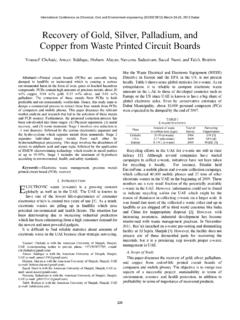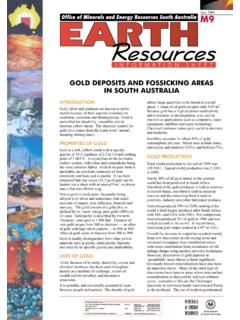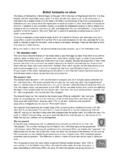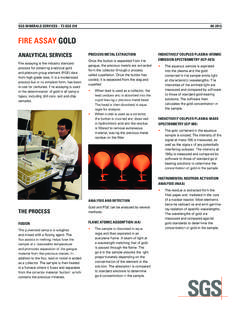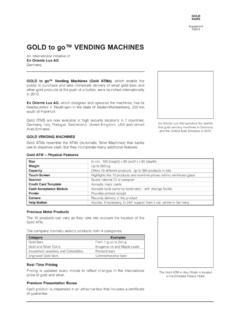Transcription of Precious Metal Flows, from the Spanish Galleons to Today
1 Precious Metal flows , from the Spanish Galleons to TodayDr. Pedro SchwartzUniversidad Camilo Jos Cela (Madrid) and Buckingham University(England)1 Columbus and Las Indias The name of Las Indias reveals what the initial incentive was Columbus wanted to reach the Portuguese Indies in the Far East through theback door The intrepid sailors that first undertook the crossing of the Atlantic in threeminimal boats of some 51 gross tons each. The flagship was a carrack, theSanta Mar a; the other two, the Pintaand the Ni a, caravels. The Santa Mar a came to grief in the Caribbean The Pinta was attacked by Barbary pirates when nearing Spain but wasable to reach port It was later that Galleons were used for the traffic with Europe Columbus may have discovered a Continent he never intended to find but hedid have the incredible persistence to look for a westward path towards the Indies 2Dr.
2 Pedro Schwartz Universidad Camilo Jos Cela (Madrid) and Buckingham University (EnglandFancied: La Ni a, La Santamar a, and la Pinta(a carrack and two caravels)3 Three strokes of luck The great Italian historian Carlo Maria Cipollaspoke of the strokes of luck of theCastilians (responding to an unslated thirst for silver in Eurasia): The trade winds In the Atlantic: south-west to the Canaries; north-west to the Caribbean; north-east to the Azores; back to Palos and Seville In the Pacific: south-west and north to the Philippines; north-east and west toAcapulco The discovery of rich mines The cerrode la plata in Potos (Per ); the silver mines of Guanajuato andZacatecas in Mexico The patio method A technical development to separate sulphur and silver by displacing it withmercury (azogue), obtained from Amad nin Spain and Huacav licain Per Increased production and helped turn Castile into a mono-product silvereconomy: the oil curse or the Dutch Disease 4Dr.)
3 Pedro Schwartz Universidad Camilo Jos Cela (Madrid) and Buckingham University (England5A flood of gold and silver American silver against the Bible Charles I (of Spain and Italy) and Charles V (of Germany and Flanders)financed his attempted rebuilding of a medieval Empire with silver and the helpof German and Italian bankers Europe was transformed by the discovery of America, as that Continent unjustlycame to be called, or the Indies, as the Castilians named it, as, through theback door, they tried to break the Portuguese spice monopoly A flood of gold and silver washed over Europe and the Eurasian Continent changing the finance of Governments giving rise to a new constellation ofpower, pitting kings and queens, bankers and merchants, pirates andprivateers, against each other transforming the world of money and finance.)
4 Transmuting trade and banks,raising the level of prices to new heights, and feeding the for silver in a hyper-inflated paper money China6Dr. Pedro Schwartz Universidad Camilo Jos Cela (Madrid) and Buckingham University (EnglandThe Castilian Kingdoms and Captaincies7 Trade with the Indies Until the beginning of the 17thcentury only a minimal part of the goodsneeded in the Americas was produced locally, by policy Carlo Maria Cipollaquotes a suggestive list of the varied merchandises onthose frail ships apart from mercury ventured westward and Precious metals eastward In 1594, the merchant Gaspar Gonzalez had the ships laden with spoons,candelabra, stills to produce rum, razors, leather goods, rosaries, crystal beadcollars, cloth, shirts, cambric, velvet, taffeta, handkerchiefs, copper lanterns,and many other things.)
5 The return goods (apart from silver ) could be scarlet cochineal, blue indigo,medicinal plants, Precious woods, sugar, tobacco, and From the Philippines, silk, porcelain, and gold : a global market!8Dr. Pedro Schwartz Universidad Camilo Jos Cela (Madrid) and Buckingham University (EnglandThe Columbian Exchange Alfred Crosby in 1972 pointed at another more important exchange From Europe to the Americas Dreadful small pox epidemics and other infectious diseases Bananas, oranges and lemons, chickens, sheep, horses, cattle, pigs,sugar cane, cotton, wheat, rice From the Americas to Europe Cacao , quinine, vanilla, rubber Plants of maize, of potatoes, tomatoes, tobacco, cotton and syphilis?)
6 And imports of gold and silver !9Dr. Pedro Schwartz Universidad Camilo Jos Cela (Madrid) and Buckingham University (England Seville byAlonso S nchez Coello (1531-1588): Museo de Am rica, Castilian trademonopoly In 1503 the overseeing body of all traffic with the Indies, La Casa de laContrataci n was established in beautiful Seville In 1717 the monopoly passed to Cadiz: one can still see the slender towers on topof houses, to exchange information with the incoming fleets Foreign merchants concentrated in the monopolising city, as they could not travel tothe Indies Only the subjects of the King of Spain in Castile, Andalusia, and Navarre wereallowed to travel to the America Even the Castilians were carefully vetted: Cervantes applied to go to America and was rejected, perhaps because he hadspent some time in prison as tax official under suspicion King Charles III freed trade within his possessions by steps (1765 to 1778), whichallowed dwellers in the Kingdom of Aragon to trade with the Indies11Dr.)
7 Pedro Schwartz Universidad Camilo Jos Cela (Madrid) and Buckingham University (EnglandPrivate mines and the royal fifthGold and silver The Crown did not own the mines in America, be they of gold or silver . They were claimed by their discoverers and were private property. The Metal obtained, however, had to be taken to the office of a public assayer to have its finenesstested and a fifth retained by the Crown. The Metal bars or cakes were engraved or punched to show all this They could then be legally sent to Spain. If they were taken to the colonial mints, the amounts had to be duly registered Smuggling was prevalent, adding up to a third onto official productionMercury mines (in Almad nand Huancav lica), however, were the property of the Crown) The Crown farmed out or managed them and then sold the mercury at monopoly prices So there was lots of smuggling of mercury at low black market prices to moonlighting silver miners12Dr.
8 Pedro Schwartz Universidad Camilo Jos Cela (Madrid) and Buckingham University (EnglandMercury transported from Huancav licaon the back of llamas13 gold officially accounted for in Seville(1503-1650)(according to Hamilton) gold : 181metric tons officially entered Seville from 1503 to 1650 Compare with the mighty 10,000 tonnes (320 million ounces) of goldproduced in the world in the last half of the nineteenth century With annual production in 1847 from 77 tonnes ( million ounces) toalmost 280 tonnes (9 million ounces) in 1852 silver was much more important for the Spanish economy and the Monarchybut gold was needed to pay the Spanish infantry in Flanders14Dr.)
9 Pedro Schwartz Universidad Camilo Jos Cela (Madrid) and Buckingham University (EnglandThree centuries of silver from the Indies If we extend the period from 1492 to 1803, officially extracted silver came tosome 82,000 mT, as reckoned by Cipolla Of which a third, after being spent by the Spanish would have been re-exported from Europe to China And a sixth more, directly to China through Acapulco and the Philippines, inexchange for silk -and gold (!) to pay the Spanish infantry in Flanders One should add an estimate of illegal production to officially registered silver Since the mercury extracted at Huancav licacame to some 16,300 mT(EspinaMontero, 2001), at an average mercury to silver ratio of : 1, weshould add some mTto the total In total 93,500 metric tonnes Compare with the 27 thousand metric tonnes of silver produced in the world in2016 alone15Dr.)
10 Pedro Schwartz Universidad Camilo Jos Cela (Madrid) and Buckingham University (EnglandReal de a ocho (Philip II)16 The reign of silver and the return of gold Much of this silver was coined, in pieces worth eight reals, realesde a ocho These pieces came to be so well accepted that they were found in Japan,China, and India. Cipollacarefully explains that in the Far East they werevalued by weight and not by tale, so that one often finds them cut in half orquarters to fit the exchange In Europe they became so popular that they were accepted at face value,which led to some authorities in Italy, for example, to forbid the circulation ofcoins proceeding from some mints in the Americas.)

